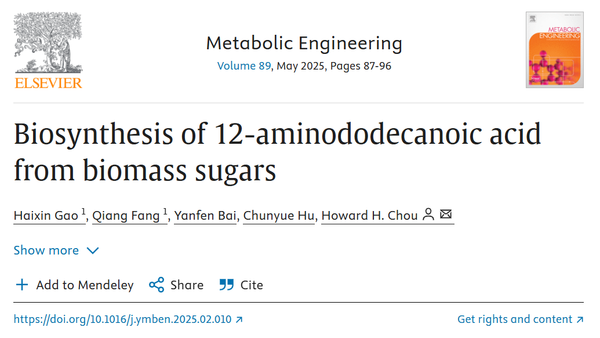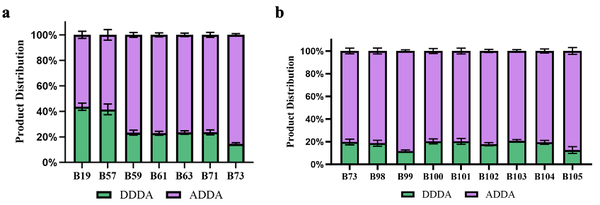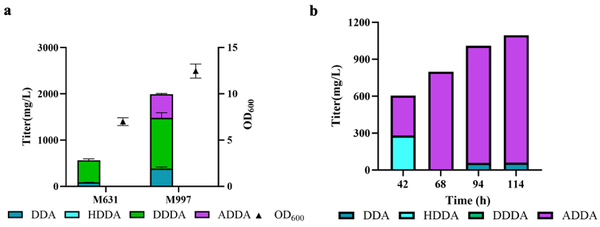Researchers achieve green synthesis of polyamide 12 using biomass sugars
Artificially synthesized polyamides, as an important class of industrial materials, are widely used in industries such as automobile manufacturing, oil pipelines, electronics, sports equipment, and medical devices, with a global market size exceeding 100 billion RMB. As the world's largest consumer market for polyamide materials, China has an annual demand of several million tons. However, the core chemical monomers for synthesizing polyamide 12 have long been monopolized by a few companies, posing significant supply risks to businesses. In addition, the synthesis of polyamide 12 relies on petroleum extraction, and the production process is highly polluting to the environment. Therefore, developing more green and sustainable technologies for the synthesis of polyamide 12 is particularly necessary.
Recently, the Howard H. Chou group from the Synthetic Biochemistry Research Center of the Institute of Synthetic Biology at the Shenzhen Institutes of Advanced Technology, Chinese Academy of Sciences, published an important research result titled "Biosynthesis of 12-aminododecanoic acid from biomass sugars" in the journal Metabolic Engineering.

The biosynthesis of 12-aminododecanoic acid (ADDA), a chemical monomer for polyamide 12, faces two major technical bottlenecks: first, the intermediate dodecanoic acid (DDA) is toxic to chassis cells; second, the accumulation of the peroxidation byproduct dodecanedioic acid (DDDA) reduces yield and increases production costs. Based on synthetic biology principles, this study elucidated the mechanisms behind these two technical bottlenecks and developed high-yield strains. This research not only deepened the understanding of the biosynthetic mechanisms of DDA, ADDA, and DDDA but also provided new insights into the green production of various polyamides.
Current research on the biosynthesis of ADDA mainly uses plant oils as raw materials, which face challenges such as high raw material prices, resource competition with food production, and associated greenhouse gas emissions and biodiversity destruction. Additionally, the biosynthesis of ADDA accumulates large amounts of DDDA, and its synthesis mechanism remains unclear (Schrewe et al., 2013; Ladkau et al., 2016; Ahsan et al., 2018). Although previous studies have achieved the synthesis of 471.5 mg/L of ADDA using glucose, the cytotoxicity of DDA still limits the improvement of yield and productivity (Ge et al., 2025).
Although the biosynthesis of ADDA provides a new paradigm for the sustainable production of polyamide 12, achieving green synthesis still requires addressing issues such as raw material selection, DDDA accumulation, and DDA cytotoxicity.
Addressing the Cytotoxicity of DDA
Experiments involving DDA addition and thioesterase (UcfatB) expression indicated that DDA is toxic to growing cells and suggested that excessive UcfatB expression can lead to a state unfavorable for DDA synthesis. The study hypothesized that the use of a quorum sensing expression (QSE) system might help regulate UcfatB expression, thereby promoting DDA synthesis. At low cell densities, the QSE system can maintain UcfatB expression at a low level during the early, more sensitive growth phase, avoiding cytotoxicity while allowing DDA accumulation. As cell density increases, after the sensitive phase, increasing UcfatB expression can maximize DDA production. Compared to constitutive expression systems, the use of the QSE system increased DDA production without inducing cytotoxicity. By combining the alkane transporter (AlkL) with the QSE system, the dynamic performance of the system was further optimized, enhancing expression intensity and uniformity while reducing background expression levels.

Figure 1. Optimizing the QSE system for fine control of DDA synthesis. (a) OD600 and DDA yield with UcfatB expressed by a constitutive promoter or a QSE-based system. (b) Expression strength of the QSE-based system under different inducer concentrations. (c) Flow cytometry analysis of cells expressing mCherry based on the QSE system.
Addressing DDDA Accumulation
During the conversion of DDA to ADDA, the intermediate 12-oxododecanoic acid may be irreversibly oxidized to DDDA. Previous studies have shown that knocking out enzymes with aldehyde reduction or oxidation activity in E. coli can increase the accumulation of aromatic aldehydes (Kunjapur et al., 2014; Butler et al., 2023). This study successfully reduced DDDA accumulation by knocking out 16 aldehyde dehydrogenases and reductases.

Figure 2. Elucidating the mechanism of DDDA synthesis. (a) Sequential knockout of 7 aldehyde dehydrogenases, and (b) individual knockout of 9 aldehyde oxidases or reductases, and their effects on DDDA accumulation.
Synthesis of ADDA from Glucose and Cellobiose
Based on a deeper understanding of DDA cytotoxicity and the mechanism of DDDA synthesis, the researchers engineered E. coli to convert glucose and cellobiose into ADDA, while reducing DDDA accumulation and the negative impact of DDA on cell growth. Under conditions where cellobiose was the primary carbon source, strain M997 achieved an ADDA yield of 509 mg/L. Strain M1001 reached 1035 mg/L in a 15-liter fermenter, with a sugar-to-ADDA conversion rate of 5%, and no detectable DDDA accumulation.

Figure 3. High-efficiency strains for ADDA synthesis from sugars. (a) M631 expressing β-glucosidase fused with OsmY (M997) with cellobiose as the primary carbon source. (b) Fermentation results of M1001.
To achieve a one-step fermentation process for the synthesis of ADDA from glucose and cellobiose, this study elucidated the bottleneck mechanisms in the biosynthesis of ADDA, finding that growing cells are more sensitive to the rate of DDA accumulation than the final DDA concentration. It also identified key genes responsible for DDDA accumulation. By improving the performance of the QSE system and more strictly regulating enzyme transcription, the study significantly enhanced the efficiency of DDA and ADDA synthesis. Finally, the developed one-step process for ADDA production achieved the highest yield and productivity to date from sugar, providing new ideas for more sustainable production of ADDA, polyamide 12, and other polyamide products in the future.
Gao Haixin, a master's graduate, and Fang Qiang, a research assistant, both from the Shenzhen Institutes of Advanced Technology, Chinese Academy of Sciences, are the co-first authors of the paper. Senior Engineer Howard H. Chou is the corresponding author. This research was supported by the National Key R&D Program, the National Natural Science Foundation of China, the Shenzhen Institute of Synthetic Biology Innovation, and the Shenzhen Major Scientific and Technological Infrastructure for Synthetic Biology Research.
【Copyright and Disclaimer】The above information is collected and organized by PlastMatch. The copyright belongs to the original author. This article is reprinted for the purpose of providing more information, and it does not imply that PlastMatch endorses the views expressed in the article or guarantees its accuracy. If there are any errors in the source attribution or if your legitimate rights have been infringed, please contact us, and we will promptly correct or remove the content. If other media, websites, or individuals use the aforementioned content, they must clearly indicate the original source and origin of the work and assume legal responsibility on their own.
Most Popular
-

List Released! Mexico Announces 50% Tariff On 1,371 China Product Categories
-

Nissan Cuts Production of New Leaf EV in Half Due to Battery Shortage
-

New Breakthrough in Domestic Adiponitrile! Observing the Rise of China's Nylon Industry Chain from Tianchen Qixiang's Production
-

Dow, Wanhua, Huntsman Intensively Raise Prices! Who Controls the Global MDI Prices?
-

Mexico officially imposes tariffs on 1,400 chinese products, with rates up to 50%






